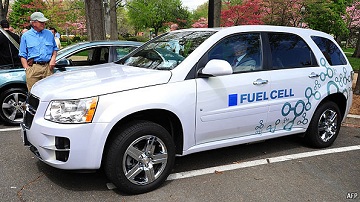Hydrogen-powered cars, The Future finally!
 “IT IS the fuel of the future—and always will be,” sceptics joke. And in recent years it was hard not to chuckle: fuel cells and other promising hydrogen technologies looked like they would remain little more than science-fair projects.
“IT IS the fuel of the future—and always will be,” sceptics joke. And in recent years it was hard not to chuckle: fuel cells and other promising hydrogen technologies looked like they would remain little more than science-fair projects.But a series of alliances suggests that things are looking up for the lightest of all elements. Carmakers are increasingly worried that building battery-powered cars will not be enough to meet tough emissions and fuel-economy standards. So hydrogen is once again gaining credibility—and the R&D dollars that could finally make it a reality.
Late last month, for instance, Toyota and BMW revealed plans to cooperate on hydrogen fuel cell research. Only days earlier Ford, Daimler and Nissan had announced they would team up in a push to bring their own fuel cell technology to market as early as 2017. “This technology has the biggest potential for emission-free driving,” said Thomas Weber, Daimler’s chief technologist.
Carmakers have been toying with the technology for years. In the mid-1990s hydrogen power was seen as a revolution in the making. The big draw was the fact that the gas could either be burned in an internal combustion engine, much like gasoline, or used in a fuel-cell stack. And the only thing to come out of the exhaust pipe would be water vapour.
Most firms focused on fuel-cell systems, in which hydrogen is forced through a membrane covered with platinum and other rare metals. In the process electrons are released, meaning that if enough hydrogen is fed through a fuel cell, it can power an electric motor.
A fuel cell may help overcome the problems of a battery-powered car, notably limited range and long charging times. But it has issues of its own. Though hydrogen is the most abundant element in the universe, it does not exist on its own. It must be stripped from other compounds, such as water or a hydrocarbon molecule. This requires a lot of energy. Other issues are shipping and storing. Keeping enough onboard a car, for instance, is a frustrating challenge.
Although carmakers reported much progress in reducing the costs of the hydrogen stack, the focus of the industry shifted to batteries, particularly after America’s government began diverting research dollars in that direction. But with battery development being much slower than expected (and with Boeing’s 787 woes putting an unwanted spotlight on the problems with lithium-batteries), hydrogen is starting to look an option again.
America’s outgoing secretary of energy, Steven Chu, recently signalled a growing interest in hydrogen after having dismissed the technology earlier and shifted more than $100m in federal research money from fuel cells to batteries. The German government, meanwhile, has provided funding for a network of alternative power service stations across the country that will offer both battery chargers and hydrogen pumps.
For the moment, hydrogen is only available in a few places. In Southern California, for instance, Honda has leased a small fleet of its FCX hydrogen fuel-cell vehicles to a select group of consumers. And in Hawaii, General Motors is testing a small fleet of hydrogen-powered Chevrolet Equinox vehicles (pictured).
Ford, Daimler and Nissan believe that the number will now grow quickly—not least thanks to their alliance and the one between BMW and Toyota. The collaboration, they hope, will send a clear signal “to suppliers, policymakers and the industry to encourage further development of hydrogen re-fuelling stations and other infrastructure necessary to allow the vehicles to be mass-marketed.” Should this call be heard, hydrogen may indeed be a fuel of the future.
You can return to the main Market News page, or press the Back button on your browser.

